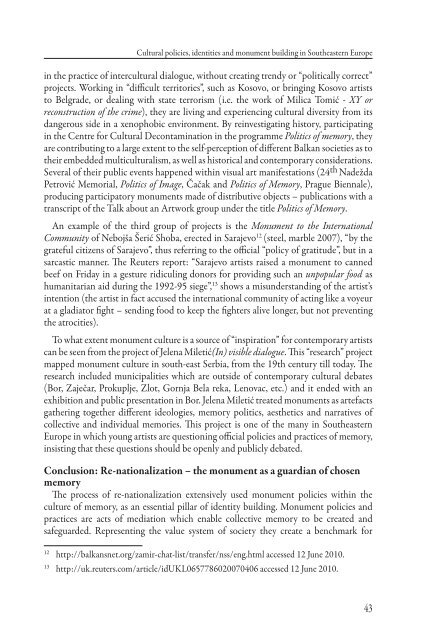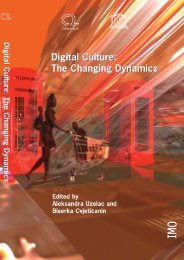free download in pdf format - Culturelink Network
free download in pdf format - Culturelink Network
free download in pdf format - Culturelink Network
Create successful ePaper yourself
Turn your PDF publications into a flip-book with our unique Google optimized e-Paper software.
Cultural policies, identities and monument build<strong>in</strong>g <strong>in</strong> Southeastern Europe<br />
<strong>in</strong> the practice of <strong>in</strong>tercultural dialogue, without creat<strong>in</strong>g trendy or “politically correct”<br />
projects. Work<strong>in</strong>g <strong>in</strong> “diffi cult territories”, such as Kosovo, or br<strong>in</strong>g<strong>in</strong>g Kosovo artists<br />
to Belgrade, or deal<strong>in</strong>g with state terrorism (i.e. the work of Milica Tomić - XY or<br />
reconstruction of the crime), they are liv<strong>in</strong>g and experienc<strong>in</strong>g cultural diversity from its<br />
dangerous side <strong>in</strong> a xenophobic environment. By re<strong>in</strong>vestigat<strong>in</strong>g history, participat<strong>in</strong>g<br />
<strong>in</strong> the Centre for Cultural Decontam<strong>in</strong>ation <strong>in</strong> the programme Politics of memory, they<br />
are contribut<strong>in</strong>g to a large extent to the self-perception of diff erent Balkan societies as to<br />
their embedded multiculturalism, as well as historical and contemporary considerations.<br />
Several of their public events happened with<strong>in</strong> visual art manifestations (24th Nadežda<br />
Petrović Memorial, Politics of Image, Čačak and Politics of Memory, Prague Biennale),<br />
produc<strong>in</strong>g participatory monuments made of distributive objects – publications with a<br />
transcript of the Talk about an Artwork group under the title Politics of Memory.<br />
An example of the third group of projects is the Monument to the International<br />
Community of Nebojša Šerić Shoba, erected <strong>in</strong> Sarajevo12 (steel, marble 2007), “by the<br />
grateful citizens of Sarajevo”, thus referr<strong>in</strong>g to the offi cial “policy of gratitude”, but <strong>in</strong> a<br />
sarcastic manner. Th e Reuters report: “Sarajevo artists raised a monument to canned<br />
beef on Friday <strong>in</strong> a gesture ridicul<strong>in</strong>g donors for provid<strong>in</strong>g such an unpopular food as<br />
humanitarian aid dur<strong>in</strong>g the 1992-95 siege”, 13 shows a misunderstand<strong>in</strong>g of the artist’s<br />
<strong>in</strong>tention (the artist <strong>in</strong> fact accused the <strong>in</strong>ternational community of act<strong>in</strong>g like a voyeur<br />
at a gladiator fi ght – send<strong>in</strong>g food to keep the fi ghters alive longer, but not prevent<strong>in</strong>g<br />
the atrocities).<br />
To what extent monument culture is a source of “<strong>in</strong>spiration” for contemporary artists<br />
can be seen from the project of Jelena Miletić(In) visible dialogue. Th is “research” project<br />
mapped monument culture <strong>in</strong> south-east Serbia, from the 19th century till today. Th e<br />
research <strong>in</strong>cluded municipalities which are outside of contemporary cultural debates<br />
(Bor, Zaječar, Prokuplje, Zlot, Gornja Bela reka, Lenovac, etc.) and it ended with an<br />
exhibition and public presentation <strong>in</strong> Bor. Jelena Miletić treated monuments as artefacts<br />
gather<strong>in</strong>g together diff erent ideologies, memory politics, aesthetics and narratives of<br />
collective and <strong>in</strong>dividual memories. Th is project is one of the many <strong>in</strong> Southeastern<br />
Europe <strong>in</strong> which young artists are question<strong>in</strong>g offi cial policies and practices of memory,<br />
<strong>in</strong>sist<strong>in</strong>g that these questions should be openly and publicly debated.<br />
Conclusion: Re-nationalization – the monument as a guardian of chosen<br />
memory<br />
Th e process of re-nationalization extensively used monument policies with<strong>in</strong> the<br />
culture of memory, as an essential pillar of identity build<strong>in</strong>g. Monument policies and<br />
practices are acts of mediation which enable collective memory to be created and<br />
safeguarded. Represent<strong>in</strong>g the value system of society they create a benchmark for<br />
12 http://balkansnet.org/zamir-chat-list/transfer/nss/eng.html accessed 12 June 2010.<br />
13 http://uk.reuters.com/article/idUKL0657786020070406 accessed 12 June 2010.<br />
43



